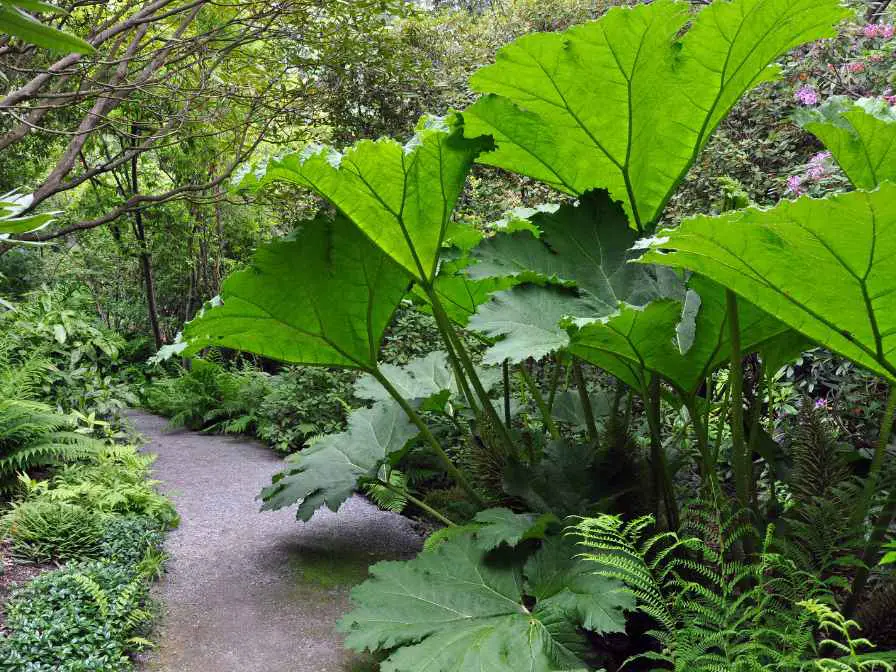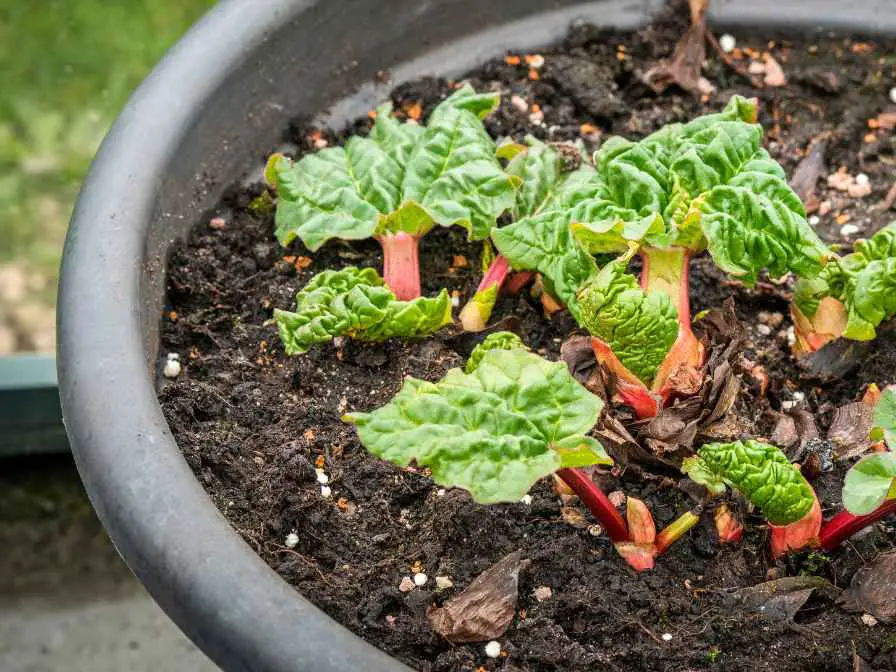Companion plants are a true blessing of nature. Whether it is a fruit or a vegetable in your garden if you managed to surround it with the right companion plants you will get a lot of benefits. People do look for companion plants, especially vegetables.

The same goes for the rhubarb plants. This vegetable is quite liked by the people who prefer a vegan lifestyle, as well as by the people who generally go for vegetables regularly. That’s why we are going to tell you about rhubarb companion plants.
Companion Planting
When different types of plants are planted near each other to provide mutual benefits, this practice is commonly known as companion planting. This can include enhancing soil fertility, pest management, pollination, and overall plant growth.
For example, planting beans and peas near corn can provide the corn with nitrogen, which the beans and peas naturally fix in the soil. Additionally, planting marigolds near tomatoes can help repel harmful insects that might damage the tomato plants.
Companion planting is a natural and sustainable method of gardening that has been practiced for centuries, and can help reduce the need for chemical pesticides and fertilizers. However, it is important to research and understands which plants complement each other and which ones might be harmful to each other before planning a companion planting garden.
Benefits of Companion Planting
There are many benefits of companion planting, as in this process you go for the other plants to be planted with the main plant. We cannot mention all of the benefits, so here are some of the important ones as follows:
Pest control in the garden
Some plants can repel pests naturally, so planting them alongside other plants can help protect them from insect damage. For example, marigolds are often planted with vegetables to repel aphids and nematodes.
Improving the soil health
Different plants have different nutrient requirements, so planting them together can help improve the overall soil health. For example, legumes like beans and peas can fix nitrogen from the air and enrich the soil, while heavy feeders like tomatoes can benefit from this added nitrogen.
Increasing the crop yield
Companion planting can increase crop yield by encouraging pollinators and beneficial insects to visit the garden. For example, planting flowers like sunflowers and the cosmos can attract bees and butterflies that will help pollinate nearby fruits and vegetables.
Saving the space in the garden
Companion planting can help maximize space in a garden by growing plants together that have different growth habits. For example, tall plants like corn can provide support for climbing beans, while low-growing plants like lettuce can fill in the spaces between them.
Biodiversity
Companion planting can help promote biodiversity in the garden by creating a diverse ecosystem of plants, insects, and animals. This can help to reduce the impact of pests and diseases and create a more resilient garden overall.
How to select companion plants?
When choosing companion plants, there are several factors to consider to ensure that the plants will work well together and provide mutual benefits. It is to make sure that these plants or the consequences of planting these plants must be useful and effective. Here are some things to keep in mind:
Compatibility
Choose plants that have similar growing requirements, such as sun and water needs. Avoid planting plants that compete with each other for resources, such as those that have deep or shallow roots. Also do consider the bloom, and dormancy season.
Also, check the spread and growth of the plants while choosing. So that one plant might not get the entire growth space of the other plant.
Pest control
Choose plants that have natural pest-repellent properties, such as marigolds or basil, to help protect other plants from insects or pests. Planting certain plants near others can also attract beneficial insects that will help to control pests.
You can choose the plant according to the pests of the main plant. So that they can repel them.
Complementary nutrients
Choose plants that have different nutrient requirements to help balance the soil. For example, legumes like beans or peas can fix nitrogen in the soil, which can benefit neighboring plants that need more nitrogen.
Growth habits
Consider the height and spread of plants when choosing companion plants. For example, tall plants like corn can provide support for climbing beans, while low-growing plants like lettuce can fill in the spaces between them.
Succession planting
Consider planting companions that have different growing seasons to maximize the use of space and extend the harvest season. For example, plant fast-growing crops like lettuce or radishes alongside slow-growing crops like tomatoes or peppers.
Crop rotation
Rotate crops each season to prevent soil-borne diseases and pests from building up in the soil. Choose companion plants that are in different families to avoid planting the same plants in the same area year after year.
Rhubarb Plant

Rhubarb (Garden rhubarb) is a perennial plant that is commonly grown for its edible stalks, which are used in a variety of sweet and savory dishes. This plants typically have large, triangular leaves and thick, fleshy stalks that range in color from light green to deep red.
Rhubarb is usually grown as a cool-season crop in temperate climates and is often harvested in the spring and early summer. Rhubarb plant is able to survive many different soil conditions and types. It does prefer well-draining, fertile soil that is high in organic matter.
Rhubarb plants require a period of cold temperatures to grow properly, so they should be planted in the fall or early winter in areas with cold winters. They also need regular watering and fertilization to ensure healthy growth and a good harvest.
Rhubarb leaves contain high levels of oxalic acid, which can be toxic if ingested in large quantities. Therefore, only the stalks of the rhubarb plant should be consumed, and the leaves should be discarded.
Companion plants of rhubarb plants
There are many plants, that can be planted as companion plants for the rhubarb plant. Here are some of the important and common companion plants of rhubarb.
Beans
Beans are nitrogen-fixing plants that can help improve soil fertility and provide a source of nitrogen for the rhubarb plant. by making the soil fertile these plants help in getting a good yield from the rhubarb as well as from beans.
Garlic
Garlic can help repel pests and insects that may attack the rhubarb plant, such as aphids and spider mites. These pests are quite common and usually attack vegetables with leaves. Moreover, garlic is the main ingredient in the kitchen as well.
Nasturtiums
Nasturtiums are flowering plants that can attract beneficial insects to the garden, such as ladybugs and lacewings, which can help control pests that may harm the rhubarb plant. Moreover, these beneficial pests can make pollination good, easy, and effective.
Onions
Onions can help repel pests and insects and also provide a source of sulfur, which can help improve the flavor of the rhubarb. Also, as an important part of the kitchen, you will get onions that can be eaten as raw as well as cooked.
Spinach
Spinach is a leafy green plant that can help provide shade for the rhubarb plant during hot summer months and also improve soil quality with its deep root system. As it complements rhubarb, rhubarb helps the spinach to grow well.
Strawberries
Strawberries are a low-growing plant that can be grown alongside rhubarb and can help suppress weeds and provide ground cover. It can also provide good shade. This will help in the good growth of the rhubarb plants.
Chives
Chives can help repel pests and insects and also attract beneficial pollinators to the garden. These plants can be easily used in cooking as well as raw. The attraction of beneficial pollinators will make the plants yield good in the garden.
Marigolds
Marigolds can help repel pests and insects, such as nematodes and whiteflies, and also provide a splash of color to the garden.
Cauliflower
Cauliflower is a smart vegetable. It helps in keeping harmful pests like white flies, and others away from the plants of rhubarb. Moreover, its big leaves also support the growth of rhubarb plants.
Tansy
Tansy is a flowering plant that can help repel pests and insects, such as ants and Japanese beetles. This process helps the rhubarb plant grow well and well.
Yarrow
Yarrow is a flowering plant that can attract beneficial insects to the garden, such as ladybugs and parasitic wasps, which can help control pests that may harm the rhubarb plant.
It’s important to note that some plants, such as brassicas (cabbage, broccoli, etc.) and fennel, should not be grown alongside rhubarb as they can compete for nutrients and may hinder the growth of the rhubarb plant.
In a nutshell, companion plants can be planted in quite an easy way. It is because nature has built the ecosystem in a way that complements each other. The same goes for rhubarb companion plants. You select them according to your ease and space. They will complement each other.

